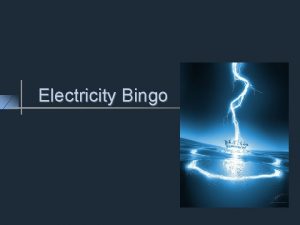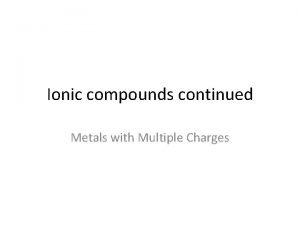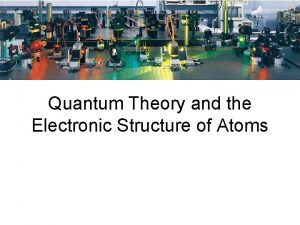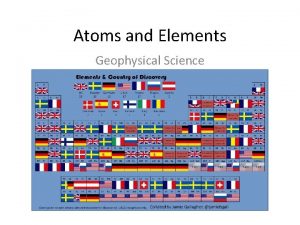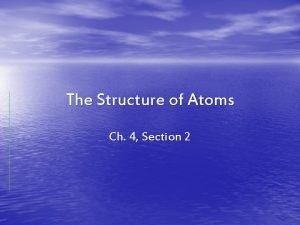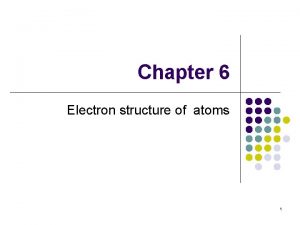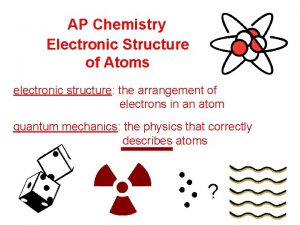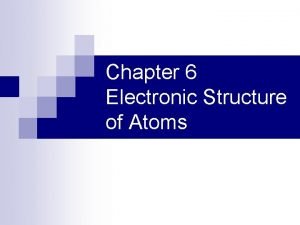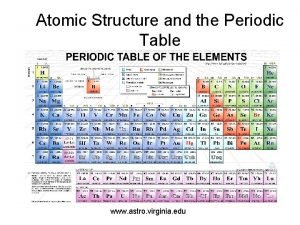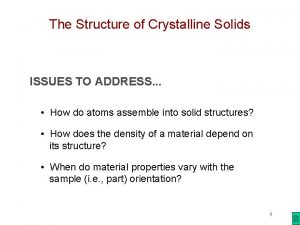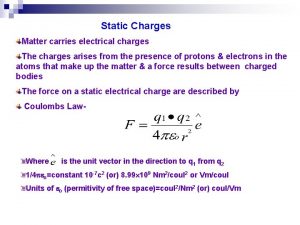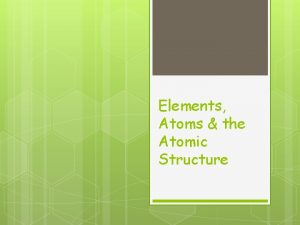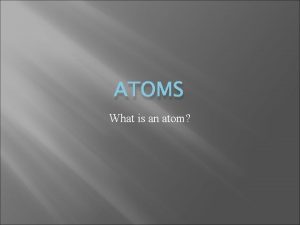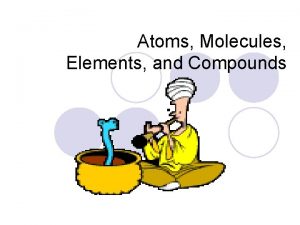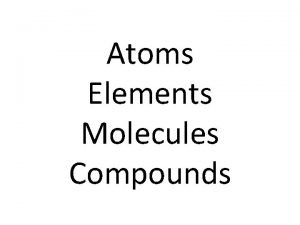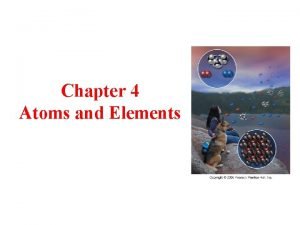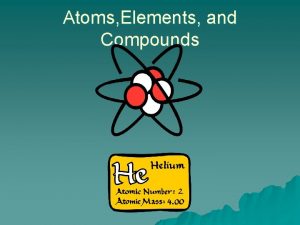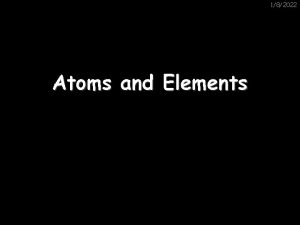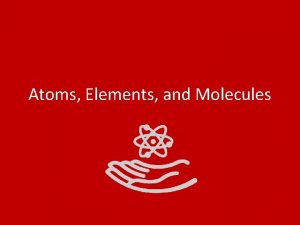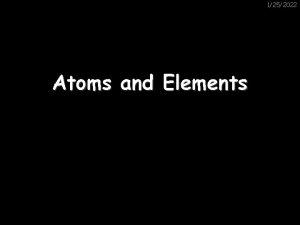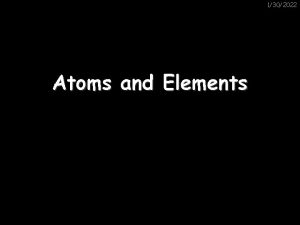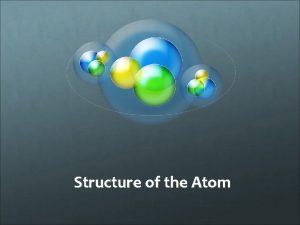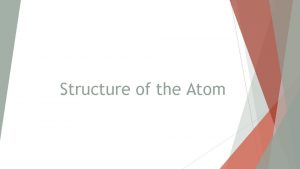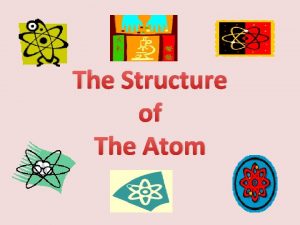Atoms and Elements Structure of an Atom Charges




















- Slides: 20

Atoms and Elements

Structure of an Atom Charges • Electron – negative • Proton – positive • Neutron - neutral Parts • Nucleus – neutrons & protons • Orbitals - electrons

Elements • Pure chemical substances made up of one type of atom • Building blocks of matter • Over 115 elements known - and more being discovered

Elements – Symbol / Name Symbol: one or two letter abbreviation Examples: C Carbon O Oxygen Mg Magnesium Br Bromine Au Lb K Na Latin Gold-aurum Lead-plumbum Potassium-kalium Sodium-natrium

Elements – Atomic Number DEFINES the element Atoms are neutral… so have same # electrons (-) as protons (+) • ALL Carbon atoms have six protons, and …ALL atoms with six protons are Carbon • BUT… they can have different numbers of neutrons These are called isotopes of carbon

Elements – Atomic Mass Calculated from Mass Number • MASS NUMBER = mass of all particles in one atom (protons, neutrons and electrons) • Measured in “atomic mass units” (amu)

Elements – Mass Number • MASS NUMBER = mass of all particles in one atom (protons, neutrons and electrons) • Mass of 1 proton = 1 amu Mass of 1 neutron = 1 amu Mass of 1 electron = really, really tiny! • SO… mass number = # protons + # neutrons Carbon • 6 protons x 1 amu/proton = 6 amu • 6 neutrons x 1 amu/neutron = 6 amu • 6 electrons x really tiny mass = 0 amu TOTAL = 6 amu + 0 amu = 12 amu

Elements – Mass Number Nitrogen Helium Atomic Number = 2 (protons) Atomic Number = 7 (protons) Mass Number = 4 amu (p + n) Mass Number = 14 amu (p + n)

Elements – Atomic Mass • BUT… Why is the atomic mass for Lithium (atomic number 3; with 3 protons) = 6. 94? !? ! NOTE: Mass number is used • …. Isotopes to name isotope Lithium-6 - 3 protons, 3 neutrons - mass number = 6 - 7. 5% of all lithium Lithium-7 - 3 protons, 4 neutrons - mass number = 7 - 92. 5 % of all lithium

Elements – Atomic Mass • BUT… Why is the atomic mass for Lithium (atomic number 3; with 3 protons) = 6. 94? !? ! • Calculation: Weighted Average (info. only): – 7. 5 % Lithium-6 at 6 amu – 92. 5 % Lithium-7 at 7 amu • (0. 075 x 6 amu) + (0. 925 x 7 amu) = (0. 45 amu) + (6. 48 amu) = 6. 93 amu

Elements – Atomic Mass • The atomic mass of an element is calculated by doing a weighted average of the mass numbers of all naturally existing isotopes. • If you round the atomic mass of an element to the nearest whole number, you get the mass number of the most common isotope. 7. 0

Elements – Symbol / Name Same # protons, different # neutrons Atomic Mass • “Average” for all carbon • Calculated from mass numbers of isotopes • On the periodic table All have same # protons Mass Number • Calculated for each individual isotope • Used to name the isotope • Averaged together to represent all carbon

Elements - SUMMARY


Structure of an Atom • Outside the nucleus electron – Electron • Atomic mass • Charge nucleus (containing protons and neutrons) 0 (-)

Structure of an Atom • Electrons are arranged in orbits – Orbit 1 holds 2 electrons – Orbit 2 holds 8 electrons – Orbit 3 holds 8 electrons…

Structure of an Atom • Nucleus – the center of an atom contains… – Protons • Atomic mass • Charge 1 (+) – Neutrons • Atomic mass • Charge 1 none

Symbols • Either 1 or 2 letters symbols – First letter Capital, second lower case – Some based on Latin name Example Latin C Carbon Au Gold-aurum O Oxygen Lb Lead-plumbum Mg Magnesium K Potassium-kalium Br Bromine Na Sodium-natrium

The Periodic Table • Elements are arranged by size and chemical properties. • Rows – Period • Size • Columns – Group • Properties

Properties • Properties are related to atomics structure. • The number of electrons in the outer most orbit (valence electrons) determine how an atom will behave in chemical reactions.
 Like charges blank and opposite charges blank
Like charges blank and opposite charges blank The structure of the atom section 2 defining the atom
The structure of the atom section 2 defining the atom At stp which substance is the best conductor of electricity
At stp which substance is the best conductor of electricity Lowest allowable energy state of an atom
Lowest allowable energy state of an atom Electrons in atoms section 2 quantum theory and the atom
Electrons in atoms section 2 quantum theory and the atom Solution
Solution Section 1 atoms elements and compounds
Section 1 atoms elements and compounds Chapter 6 section 1 atoms elements and compounds answer key
Chapter 6 section 1 atoms elements and compounds answer key Chapter 6 section 1 atoms elements and compounds
Chapter 6 section 1 atoms elements and compounds Relationship between atoms and molecules
Relationship between atoms and molecules How are metals with multiple charges named
How are metals with multiple charges named Kelemahan teori atom bohr adalah
Kelemahan teori atom bohr adalah Quantum theory and the electronic structure of atoms
Quantum theory and the electronic structure of atoms Expanded octet
Expanded octet Www.chem.purdue/gchelp/atoms/elements.html
Www.chem.purdue/gchelp/atoms/elements.html Chapter 4 section 2 the structure of atoms answer key
Chapter 4 section 2 the structure of atoms answer key Chapter 6 electronic structure of atoms answers
Chapter 6 electronic structure of atoms answers Ap chemistry electronic structure of atoms
Ap chemistry electronic structure of atoms Electronic structure of atoms
Electronic structure of atoms Periodic table and atomic structure
Periodic table and atomic structure Packing fraction of bcc
Packing fraction of bcc
